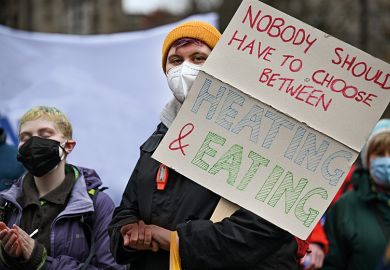In an email to employees last week, Boston University president Robert Brown outlined many familiar challenges in higher education today: the need to help Ukrainian students affected by the war in their homeland, lingering concerns about the coronavirus pandemic and difficulty hiring and retaining talent amid the Great Resignation, which has prompted many workers to leave their jobs.
But above all, Professor Brown described inflation as his biggest worry.
“By far, my greatest immediate concern is the impact of inflation on faculty and staff, our students, and the university. We have increased undergraduate tuition [by] 4.25 per cent for the coming academic year, our largest increase in 14 years, following an increase of only 3.0 per cent last year,” Professor Brown wrote.
“This increase does not keep pace with the current national rate of inflation and cannot fully offset the increased costs of university operations or fund salary increases that would fully mitigate the effects of inflation on the families of faculty and staff. I also am mindful that our students and their families are affected by our increases and by inflation. We are caught in an inflationary vice between the institutional pressures and the impact on our students and their families.”
This near-historic tuition increase comes on the heels of the best fundraising year in history for Boston University, which brought in $225 million (£184 million) in philanthropic support in 2021.
Professor Brown is not alone in his concerns about inflation: colleges across the country are grappling with its effects. Nor is Boston the only institution to raise tuition prices. Looking ahead, experts say sharp tuition increases may become more frequent if inflation doesn’t slow.
Colleges are being squeezed in many of the same ways that American households are.
“Inflation is real. And it may be a talking point for institutions as they defend price increases in the coming years, but they’re absolutely facing higher costs that all of us are facing throughout the economy today,” said Beth Akers, a senior fellow at the centre-right thinktank the American Enterprise Institute and an economist by training. “Just like we all face higher prices for goods and services, they are also having to raise wages that they pay to their faculty, as well as support staff and administration.”
And while colleges may be paying more for things such as fuel, utilities, food, healthcare and other essentials, some experts note that increasing tuition will go only so far in relieving cost pressures caused by inflation – meaning that it’s only one part of institutional financial planning.
“Rarely do tuition increases cover all the costs that are expected, which will mean reductions in other areas to do what institutions feel are the basic essentials that they need to get done,” said Jim Hundrieser, vice-president of consulting services for the National Association of College and University Business Officers.
Dr Hundrieser added that he expects near-historic tuition increases, like the one at Boston University, to become more common either this year or next year if inflation doesn’t ease soon.
The current inflation rate is 8.3 per cent over the past 12 months, according to data released by the US Bureau of Labor Statistics. That number marks a small decrease of 0.3 per cent since March, when inflation hit the highest rate since April 1981.
And when prices go up, they often don’t go back down – which means certain costs will remain high even if inflation slows.
“Those are real price increases that will not go away,” Dr Akers said. “Even as we talk about inflation slowing in the future, we’re not going to see prices revert. When we talk about a target inflation rate, it’s still a positive inflation rate. So we’ll continue to see prices that institutions have to respond to with increasing tuition costs in order for the institutions to recoup the expenses that they face, just for those everyday expenses that we all face that are increasing as well.”
Tuition is rising at many colleges this year, public and private. This comes after two years of historically low tuition increases, according to an annual trends report from the College Board.
While a comprehensive assessment of tuition hikes for this year is not yet available, a cursory glance shows that plenty of increases have been approved or are currently being considered. In December, the University of Virginia approved an 8.4 per cent increase in undergraduate tuition and fees over the next two years; the Oregon Institute of Technology raised undergraduate tuition by 6.6 per cent, or 7 per cent when students fees are included; and Syracuse University increased tuition by 4.5 per cent, just to name a few examples of institutions outpacing the 4.25 per cent increase at Boston University, its highest since the Great Recession.
The University of Virginia previously described the tuition increase as “a reaction to rising university operating costs across a wide range of sectors”. And like some others, it pointed to inflation as one of the driving forces for the increase.
“These new tuition rates will help the university balance its annual budget in an inflationary environment, while maintaining our commitment to accessibility and to value,” UVA president Jim Ryan said in a December news release when the two-year tuition increase was approved.
While some colleges have broad leeway to increase tuition, others face legal constraints. That’s the case in Washington, where a 2017 state law capped tuition increases at public colleges for in-state undergraduate students, although it allows flexibility for other categories of students.
The Washington State University board of regents approved a 2.4 per cent tuition increase for undergraduates this month. While WSU faces multiple challenges – including inflation, declining enrolment and rising compensation costs – that’s as far as the university is allowed to go.
“Honestly, I think inflation is just compounding the challenges we’re facing,” said Phil Weiler, vice-president of marketing and communications at Washington State, who also pointed to declining enrolment at the state community colleges that regularly stock WSU with transfer students.
Before the law limited tuition increases, Mr Weiler noted that pricing had been subject to “wild gyrations”. Tuition climbed by as much as 15 per cent a year in the aftermath of the Great Recession. Now the university aims for predictability and expects a 2.5 per cent increase to be consistent year over year for in-state undergraduates. But that may not be the case for out-of-state and graduate students.
“The law specifically says the legislature will set a cap for how much tuition at public universities can be raised for resident undergraduate students,” Mr Weiler explained. “That’s a large percentage of our student body, but it’s not the only category of students. We have non-resident undergraduates, we have resident graduate students, non-resident graduate students and, of course, we have international students. The university has flexibility on all those other categories of students.”
Regardless of the category, however, tuition increases stayed within 5 per cent for all students.
Some experts warn that on top of inflation, certain government policies could drive tuition costs up more. Dr Akers, at the conservative-leaning American Enterprise Institute, suggests that if the federal government forgives student loan debt, tuition will rise accordingly.
“My concern, as it relates to inflation, with that policy is that by cancelling debt, we’re putting in place an implicit guarantee that people taking on debt tomorrow will also face some sort of bailout of their borrowing so that they won’t be on the hook to repay all they have borrowed,” Dr Akers said. “And the concern is that as a borrower, as somebody who’s choosing how much to spend, how much to borrow for college, I’m going to be inclined to spend more than I would have otherwise if I believe that someone’s going to swoop in and relieve me of my debts in the future.”
If students are willing to borrow more on the assumption that their loans will be forgiven, Dr Akers suggests that that relieves the pressure on colleges to keep the costs of education down.
“You don’t need to be a predatory institution to respond to incentives in this way,” Dr Akers said. “When institutions don’t need to be as competitive on prices to compete for the students that they want to apply, then they’re going to be less aggressive in trying to contain prices, and the natural outcome is that prices will increase.”
This is an edited version of a story which first appeared on Inside Higher Ed.
Register to continue
Why register?
- Registration is free and only takes a moment
- Once registered, you can read 3 articles a month
- Sign up for our newsletter
Subscribe
Or subscribe for unlimited access to:
- Unlimited access to news, views, insights & reviews
- Digital editions
- Digital access to THE’s university and college rankings analysis
Already registered or a current subscriber?








